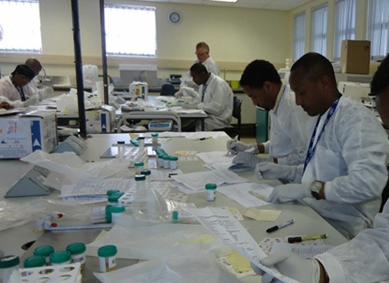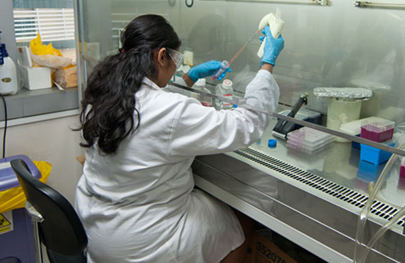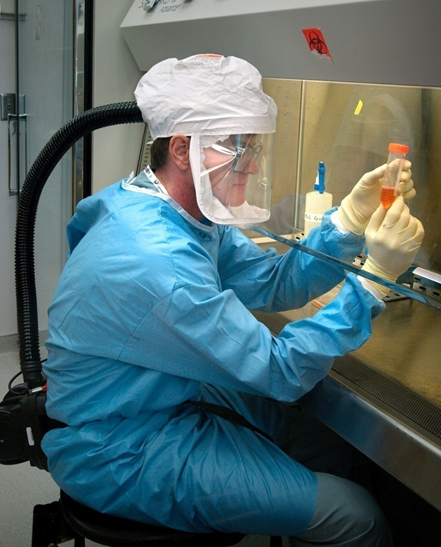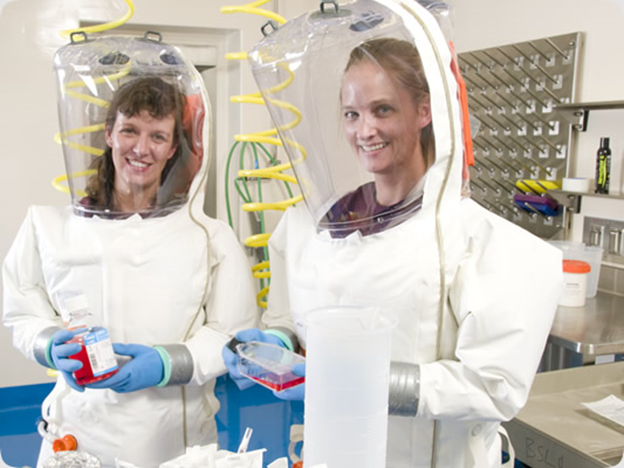Pathogenic microorganisms inclusive of viruses, bacteria, and fungi portends health challenges to the general public and healthcare workers or laboratory personnel’s working with these organisms if the proper precautionary measures are not followed in the handling of these microbes. The extensive use of these organisms in research settings or hospital laboratories should be done within the required limits that prevent the escape of pathogenic microorganisms from the laboratory environment into the environment. Safe methods are used in the laboratories to ensure that potential pathogens or high risk biological agents do not cause disease in those working with them. These measures also help to restrict the escape of these microbes from the laboratory environment into the community.
Containment is defined as the safe methods employed within the laboratory for managing infectious agents. The main goal of containment in the laboratory is to ensure that hazardous substances do not escape into the outside environment, and that laboratory workers are not exposed to these organisms too. Every good laboratory practice (GLP) has in it specified containment measures that help to restrain the nefarious activities of potentially harmful biological agents including microorganisms.
HAZARD GROUP 1 LABORATORIES (BSL-1)
Hazard group 1 laboratories handle microorganisms that are not known to consistently cause disease in healthy human adults. These laboratories are also known as biosafety level one (BSL-1) laboratories. Microorganisms handled in this laboratory are indicated as LOW RISK ORGANISMS – because they pose little or no health risk to laboratory personnel and the environment. They have minimal or low effect on laboratory workers and the community; and work on such organisms is normally carried out on open bench tops (Figure 1). Such microorganisms normally result from basic laboratory settings where the routine laboratory work/procedures executed are usually open bench work. Ensuring good microbiological techniques will help to prevent laboratory workers from any form of contamination or infection with microorganisms. Hazard group 1 organisms may include bacteria, fungi and protozoa; and they are usually found in research laboratories and some hospitals. Non-infectious bacteria, non-pathogenic Escherichia coli, and canine hepatitis are some examples of microorganisms handled in biosafety level one (BSL-1) laboratories.

HAZARD GROUP 2 LABORATORIES (BSL-2)
Hazard group 2 laboratories deal with microorganisms that are usually found in basic laboratories just as hazard group 1 microorganisms. They can also be called biosafety level two (BSL-2) laboratories. Microorganisms in this category are generally regarded as MODERATE and LOW RISK to individuals and the community respectively. They are mainly found in clinical laboratories in most hospitals where patient’s specimens (from in- and out-patient) are processed. The microorganisms in this category only cause mild disease in healthy human adults, and they cannot be transmitted or acquired through aerosols in the laboratory environment.
Such laboratories must be fitted with a biosafety laminar flow cabinet or hood where clinical specimens and microorganisms can be handled in order to minimize harm to the laboratory worker (Figure 2). The hood helps to contain aerosols that might arise from the work going on in it. In addition to good microbiological techniques, laboratory workers in such facility must ensure that the always put on their protective clothing’s or laboratory gown when working and within the laboratory.

Laboratory procedures are usually undertaken in a biosafety laminar flow cabinet and sometimes on open laboratory workbench. Biohazard signs are usually placed on the doors and other areas of the laboratory as a caution to health personnel’s, patients and non-health personnel’s visiting the facility. The microorganisms encountered in this group are usually bacteria, fungi and protozoa. Typical examples of microorganisms handled in BSL-2 laboratories include Chlamydia, Hepatitis A, B, and C, Influenza A, and Salmonella.
HAZARD GROUP 3 LABORATORIES (BSL-3)
The hazard group 3 laboratories deal with microorganisms that are usually encountered in facilities termed “containment laboratory”. Microorganisms found in such a laboratory are usually HIGH RISK and LOW RISK to individuals and community respectively. Hazard group three laboratories can also be called biosafety level 3 (BSL-3) laboratories. The microorganisms handled in BSL-3 laboratories can cause serious or potentially lethal disease through respiratory transmission; and thus they can be easily acquired or transmitted via aerosols. The work performed in such a facility is always performed in a safety cabinet as precaution to avoid aerosols from spreading and coming into contact with workers.
Special precautionary measures are taken in BSL-3 laboratories when working with microbes; and special laboratory clothing’s and equipment are normally worn in such a laboratory to protect laboratory personnel from contamination by pathogens (Figure 3). There is restriction of movement in such a facility, and non-health or non-laboratory workers are normally denied access into such a laboratory. Access to the containment laboratory is strictly regulated, and each of the doors is fitted with the international biohazard warning signs. Special precautions in addition to those observed in hazard group 2 laboratories are taken in containment laboratories handling organisms that are hazard group 3. The microorganisms encountered in this group are usually bacteria, fungi, protozoa and some viruses. Typical examples of microorganisms handled in BSL-3 laboratories include HIV, Yersinia pestis, H1N1 influenza virus, Mycobacterium tuberculosis, Rickettsia, West Nile Virus, SARS and Rabies virus.

- HAZARD GROUP 4 LABORATORIES
Microorganisms in hazard group 4 laboratories are always HIGH RISK. They are VERY HIGH RISK to individuals and community. The microorganisms encountered in this group are always viruses. Hazard group 4 laboratories are maximum containment laboratories; and they can also be called biosafety level four (BSL-4) laboratories. Such facilities are usually fitted with special waste disposal bins, air lock systems and special biosafety cabinets (called class III safety cabinet). Laboratory workers working in such laboratories usually wear protective clothing or equipment that covers their whole body and they have special oxygen supply that enable them to do their work (Figure 4). Precautions taken in level 3 laboratories are also ensured here with some other stricter safety measures. Such laboratories are normally manned and guarded specially by the government, and the security in such laboratories is high-tech. Access is always denied to visitors and those who have no reasonable business within the facility. Ebola virus and smallpox virus are typical examples of microorganisms handled in BSL-4 laboratories.

It is advisable that scientists or health personnel working in the laboratory (irrespective of the biohazard level) always follow and keep to good training and standard microbiological techniques. Personal protection should not be taken nonchalantly, and laboratory scientists/workers (inclusive of students) must always imbibe and stick to careful work while following already laid down rules and safety measures to evade any form of contamination or infection in the course of their work. Only trained laboratory personnel should receive, handle, and examine specimens or microorganisms that come to the microbiology laboratory. Hand washing, use of hand gloves, wearing of laboratory gowns and safety/eye glasses in addition to other precautionary measures should not be taken for granted in the clinical microbiology laboratory because microorganisms are ubiquitous and they can cause harm when given the opportunity. Prevention is better than cure!
REFERENCES
Atlas R.M (2010). Handbook of Microbiological Media. Fourth edition. American Society of Microbiology Press, USA.
Balows A, Hausler W, Herrmann K.L, Isenberg H.D and Shadomy H.J (1991). Manual of clinical microbiology. 5th ed. American Society of Microbiology Press, USA.
Beers M.H., Porter R.S., Jones T.V., Kaplan J.L and Berkwits M (2006). The Merck Manual of Diagnosis and Therapy. Eighteenth edition. Merck & Co., Inc, USA.
Black, J.G. (2008). Microbiology: Principles and Explorations (7th ed.). Hoboken, NJ: J. Wiley & Sons.
Brooks G.F., Butel J.S and Morse S.A (2004). Medical Microbiology, 23rd edition. McGraw Hill Publishers. USA. Pp. 248-260.
Dictionary of Microbiology and Molecular Biology, 3rd Edition. Paul Singleton and Diana Sainsbury. 2006, John Wiley & Sons Ltd. Canada.
Dubey, R. C. and Maheshwari, D. K. (2004). Practical Microbiology. S.Chand and Company LTD, New Delhi, India.
Garcia L.S (2010). Clinical Microbiology Procedures Handbook. Third edition. American Society of Microbiology Press, USA.
Garcia L.S (2014). Clinical Laboratory Management. First edition. American Society of Microbiology Press, USA.
Madigan M.T., Martinko J.M., Dunlap P.V and Clark D.P (2009). Brock Biology of Microorganisms, 12th edition. Pearson Benjamin Cummings Inc, USA.
Mahon C. R, Lehman D.C and Manuselis G (2011). Textbook of Diagnostic Microbiology. Fourth edition. Saunders Publishers, USA.
Prescott L.M., Harley J.P and Klein D.A (2005). Microbiology. 6th ed. McGraw Hill Publishers, USA. Pp. 296-299.
Ryan K, Ray C.G, Ahmed N, Drew W.L and Plorde J (2010). Sherris Medical Microbiology. Fifth edition. McGraw-Hill Publishers, USA.
Salyers A.A and Whitt D.D (2001). Microbiology: diversity, disease, and the environment. Fitzgerald Science Press Inc. Maryland, USA.
Discover more from #1 Microbiology Resource Hub
Subscribe to get the latest posts to your email.


